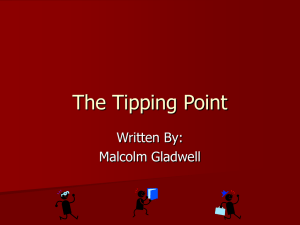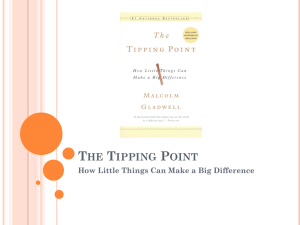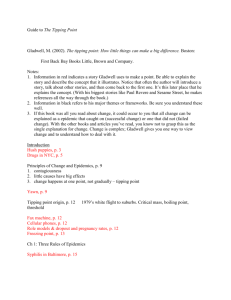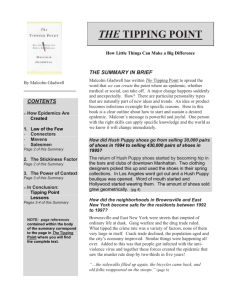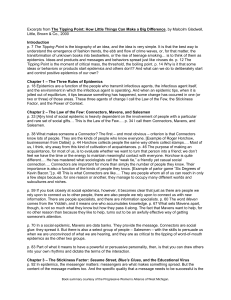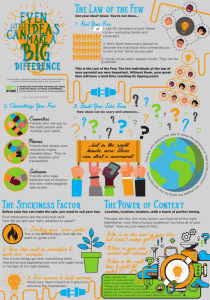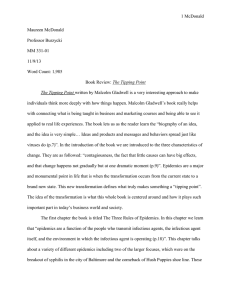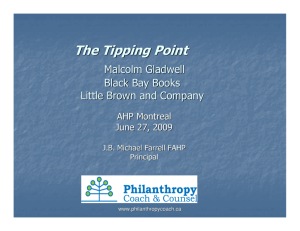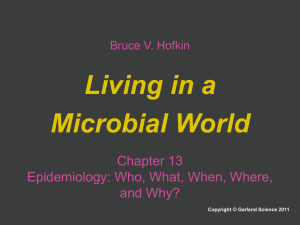Excerpts from The Tipping Point
advertisement
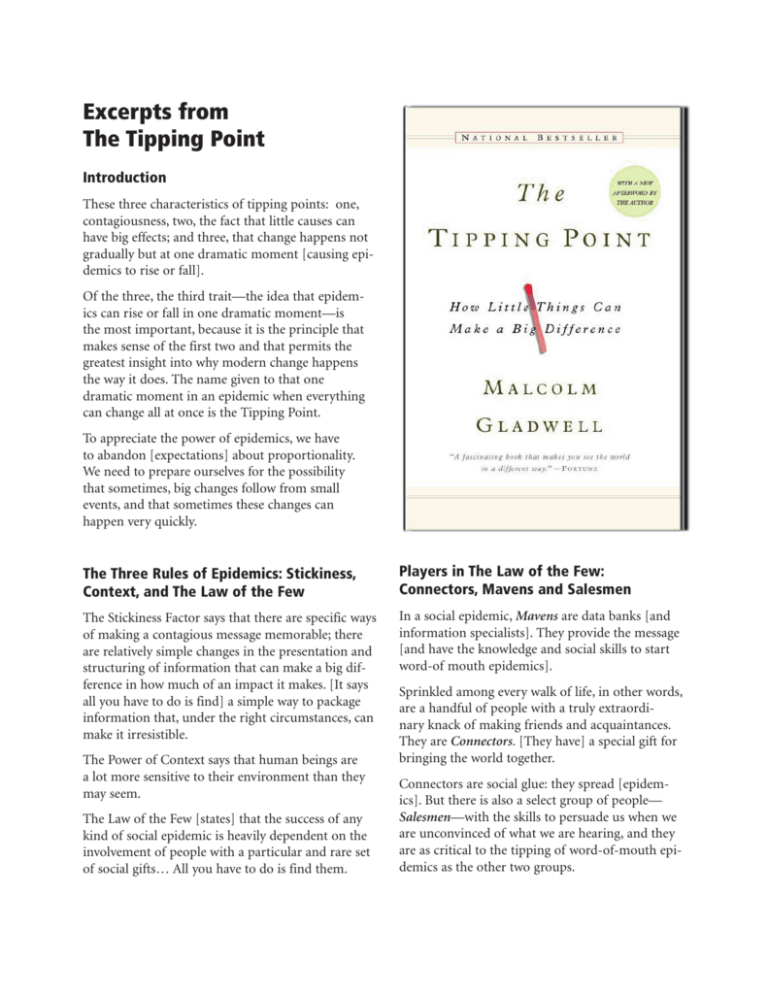
Excerpts from The Tipping Point Introduction These three characteristics of tipping points: one, contagiousness, two, the fact that little causes can have big effects; and three, that change happens not gradually but at one dramatic moment [causing epidemics to rise or fall]. Of the three, the third trait—the idea that epidemics can rise or fall in one dramatic moment—is the most important, because it is the principle that makes sense of the first two and that permits the greatest insight into why modern change happens the way it does. The name given to that one dramatic moment in an epidemic when everything can change all at once is the Tipping Point. To appreciate the power of epidemics, we have to abandon [expectations] about proportionality. We need to prepare ourselves for the possibility that sometimes, big changes follow from small events, and that sometimes these changes can happen very quickly. The Three Rules of Epidemics: Stickiness, Context, and The Law of the Few Players in The Law of the Few: Connectors, Mavens and Salesmen The Stickiness Factor says that there are specific ways of making a contagious message memorable; there are relatively simple changes in the presentation and structuring of information that can make a big difference in how much of an impact it makes. [It says all you have to do is find] a simple way to package information that, under the right circumstances, can make it irresistible. In a social epidemic, Mavens are data banks [and information specialists]. They provide the message [and have the knowledge and social skills to start word-of mouth epidemics]. The Power of Context says that human beings are a lot more sensitive to their environment than they may seem. The Law of the Few [states] that the success of any kind of social epidemic is heavily dependent on the involvement of people with a particular and rare set of social gifts… All you have to do is find them. Sprinkled among every walk of life, in other words, are a handful of people with a truly extraordinary knack of making friends and acquaintances. They are Connectors. [They have] a special gift for bringing the world together. Connectors are social glue: they spread [epidemics]. But there is also a select group of people— Salesmen—with the skills to persuade us when we are unconvinced of what we are hearing, and they are as critical to the tipping of word-of-mouth epidemics as the other two groups. The Power of Context Epidemics are sensitive to the conditions and circumstances of the times and places in which they occur… The impetus to engage in a certain behavior is not coming from a certain kind of person but from a feature of the environment. Classifying the Larger Population: Innovators, Early Adopters, Early Majority, Late Majority, and Laggards/Non-Adopters The Innovators were the adventurous ones. The slightly larger group who were infected by them were the Early Adopters. They were the opinion leaders in the community, the respected, thoughtful people who watched and analyzed what those wild Innovators were doing and then followed suit. Then came the big bulge of farmers in 1936, 1937, and 1938, Early Majority and the Late Majority, the deliberate and the skeptical mass, who would never try anything until the most respected of farmers had tried it first. They caught the seed virus and passed it on, finally, to the Laggards, the most traditional of all, who see no urgent reason to change. Innovations don’t just slide effortlessly from one group to the next. There is a chasm between them. All kinds of high-tech products fail, never making it beyond the Early Adopters, because the companies that make then can’t find a way to transform an idea that makes perfect sense to an Early Adopter into one that makes perfect sense to a member of the Early Majority. This is where, I think, Connectors, Mavens, and Salesmen play their most important role. [The Law of the Few talks] about how their special social gifts can cause epidemics to tip. Conclusion What must underlie successful epidemics, in the end, is a bedrock belief that change is possible, that people can radically transform their behavior or beliefs in the face of the right kind of impetus. We are actually powerfully influenced by our surroundings, our immediate context, and the personalities of those around us. Merely by manipulating the size of a group, we can dramatically improve its receptivity to new ideas. By tinkering with the presentation of information, we can significantly improve its stickiness. Simply by finding and reaching those few people who hold so much social power, we can shape the course of social epidemics. In the end, Tipping Points are a reaffirmation of the potential for change and the power of intelligent action.
